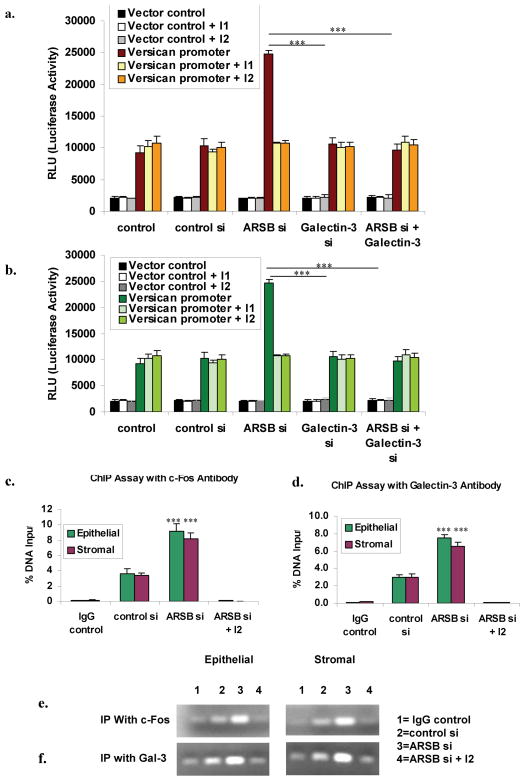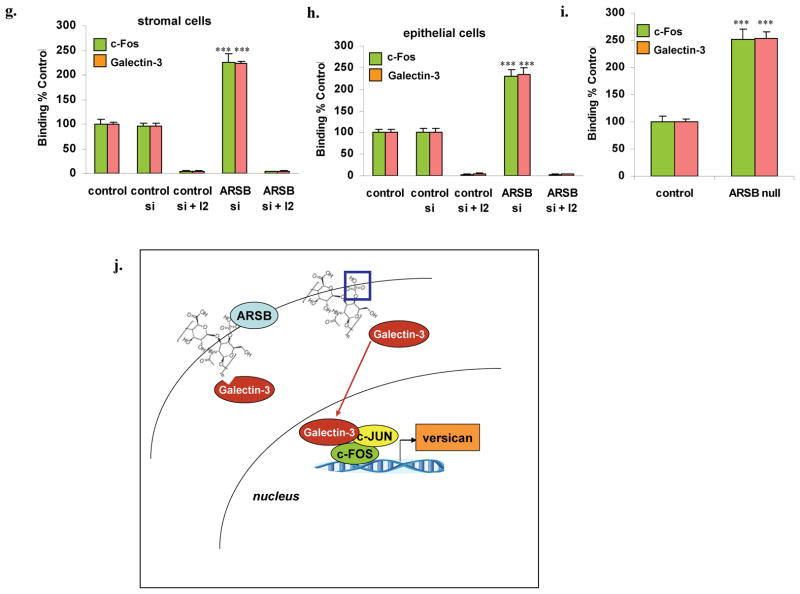FIGURE 5. ARSB silencing increases versican promoter activity, and this increase is blocked by galectin-3 silencing and by AP-1 inhibitors.
Panel A. To further assess the impact of ARSB silencing and galectin-3 silencing on versican expression, versican promoter activity was determined following ARSB silencing, galectin-3 silencing, and the combination of ARSB and galectin-3 silencing. In the prostate stromal cells, ARSB silencing increased versican promoter activity to 3.14 times the baseline (p<0.001). This increase was completely inhibited when both ARSB and galectin-3 were silenced. Negative vector control demonstrates no changes; positive actin control is not shown. No further decline in versican promoter activity occurred when ARSB and galectin-3 were both silenced and the inhibitors were present.
Panel B. In the prostate epithelial cells, when ARSB was silenced, versican promoter activity increased to 2.70 times the baseline activity (p<0.001). This increase was completely abrogated by the combination of ARSB and galectin-3 silencing, demonstrating dependence of the ARSB knockdown-induced effect on the versican promoter on galectin-3, and consistent with the observed change in galectin-3 binding to C4S when ARSB was silenced. [ARSB=Arylsulfatase b; C4S=chondroitin-4-sulfate]
Panel C. Chromatin immunoprecitiation (CHiP) assay was performed with c-Fos antibody following ARSB silencing and in the presence of c-Fos oligonucleotide binding inhibitor (I2). Epithelial and stromal cells showed significant increases in % DNA captured following ARSB silencing. Panel D. CHiP assay with galectin-3 antibody also demonstrated increase following ARSB silencing that was inhbited in the presence of I2.
Panel E. Increased intensity of the chromatin bands is apparent following immunoprecipitation in the presence of c-Fos in the stromal and epithelial cells.
Panel F. Similarly, immunoprecipitation with galectin-3 demonstrates increased band intensity following ARSB silencing.
Panel G. c-Fos from the nuclear fraction of stromal cells bound with to the AP-1 binding sequence coated onto the wells of an ELISA plate. Anti-rabbit c-Fos and secondary goat-anti-rabbit-IgG-FITC were used to detect the c-Fos and were measured by fluorescence. Following ARSB silencing, the bound c-Fos was 2.25 and 2.30 times the baseline level in the stromal cells and in the epithelial cells, respectively. The I2 inhibitor completely blocked the binding.
Panel H. Galectin-3 binding to the AP-1 oligonucleotide consensus sequence was also increased following ARSB silencing and inhibited by I2. When galectin-3 binding was detected by a mouse anti-galectin antibody and goat anti-mouse-IgG-Rhodamine Red™X, the binding was shown to have increased to 4.3 and 4.3 times the baseline, in the stromal and epithelial cells, respectively.
Panel I. In the ARSB null mouse prostate tissue, the nuclear c-Fos and galectin-3 were both increased. C-Fos increased to 2.51 times the baseline and galectin-3 to 2.54 times the baseline (p=0.0002, p<0.0001, unpaired t-test, two-tailed).
Panel J. Schematic diagram shows reduced binding of galectin-3 to more sulfated chondroitin-4-sulfate (C4S) that is present when ARSB is diminished. This is associated with increased nuclear galectin-3 and increased association of galectin-3 with c-Jun and c-Fos, leading to increased transcription of versican. [ARSB=arylsulfatase B; blue box = sulfate group at non-reducing end of C4S].


